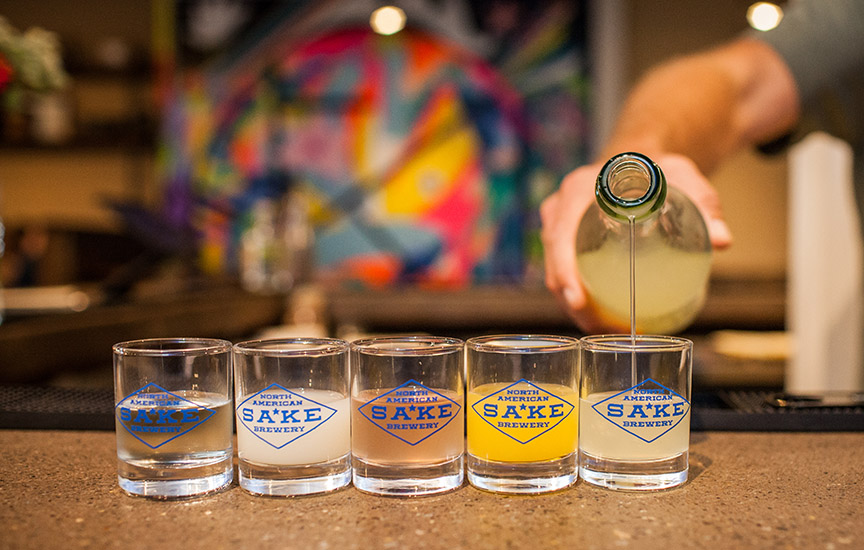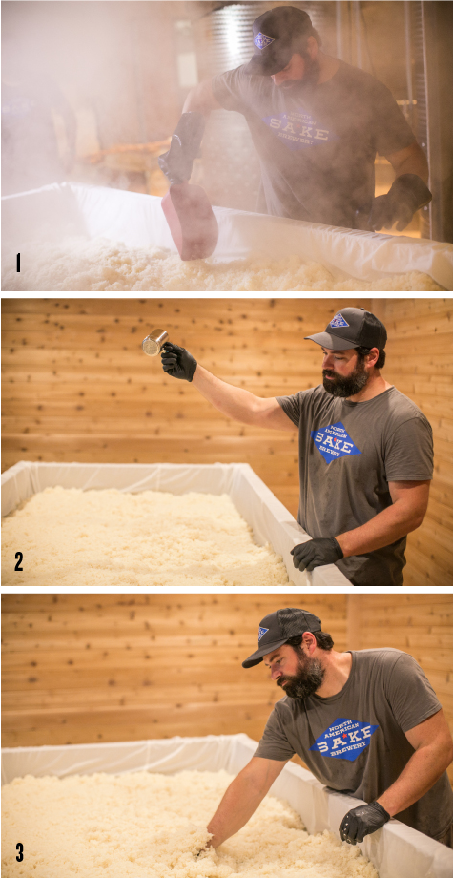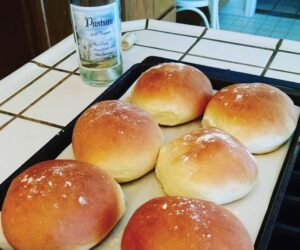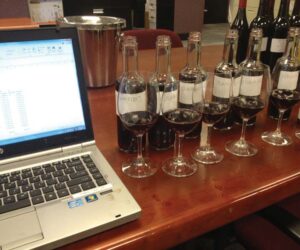
Sake! The delicious alcoholic beverage that hails from Japan is one of the most historic, interesting, difficult, nuanced, and beautiful beverages in existence. It is shrouded in mystery and often overlooked as a beverage home winemakers can create using household items found in most kitchens, equipment used in the production of wine, beer, and other fermented beverages, and a couple of other items. As a craft sake producer who started down that path making sake at home for years, I’m here to try to clear up some of that mystery and dive deep into why sake is one of the most exciting and interesting beverages to try to make at home. Beware, this process is not for the faint of heart, may lead to a serious sake brewing habit, and may take some time to wrap your brain around. The best advice I have is to try to be flexible and to keep an open mind. Kanpai!
Basics on the Beverage
First things first, sake is made from rice and if you didn’t know, rice is a grain. The term “rice wine” is actually not accurate as sake is a brewed product, more similar to beer than anything else. There are no natural sugars in rice and rice is not a fruit, so wine is not the right word. I can see how people may confuse it as it does have a higher ABV and you do sip it for its complexity and nuance of character, you can also pair it with an assortment of food, just like wine. It is also not distilled, so it is not a liquor. This is an opportunity to let sake be sake, a category unto its own, and when you give it that space to be itself, I think you will find it makes more sense.
Sake is also naturally gluten-free, low in sugars, high in alcohol, easy to drink, and has a wide variety of style, regionality, and variation. It can be served warm or cold. It can be sipped and contemplated, casually drunk at the end of a long day, or used to celebrate with friends. I think many people put sake into too small of a box, confining it to the sushi joint or think it’s just a singular drink that they tried one time, hot as hell, at a hibachi. That’s like only trying a $3 white Zinfandel and thinking that’s what all wine tastes like! Sake is nuanced, can be sweet or dry, rich or light, fruity or earthy, floral, and aromatic, and is the king of umami, that mysterious fifth sense. I recommend drinking more sake to try to understand some of its variation because there is a whole spectrum of sake out there to explore. I also think, if you are gonna try to make it, you might as well know what you are trying to accomplish.

A Little History
Sake is over 2,000 years old with origins in China at the start of rice cultivation, but really it was perfected by the Japanese. Like most alcohol, it was brewed for religious ceremonies, specifically in Shinto shrines and Buddhist temples pertaining to the seasons. In Japan, sake was historically made in the winter to allow the tanks to become cold enough for proper sake production. As time passed it began to be drunk by the masses and lighter styles, more techniques, and more technology was introduced. During the Meiji period (1850–1912) there was a massive growth in the popularity of sake and it is said there were over 27,000 sake breweries in Japan. (I like to compare this to our current craft beer scene with a brewery or two popping up in every town). The World Wars greatly affected sake breweries with the country rationing rice, forcing many breweries to blend with cheaply distilled alcohol. The 1970s brought sake back with more advancements of rice polishing and a resurgence of high quality products and techniques. These new styles refined flavor and aroma as well as pushed toward more artisan sake.
Today sake is experiencing an international resurgence with America being the highest importer of sake. New craft sake breweries in the U.S. are popping up around the country while the general population is embracing this ancient drink.
How It’s Made: The Broad Strokes

1) Rice is steamed before it is used in koji making or to build the mash. At North American Sake Brewery we steam over 1,500 lbs. (680 kg) of rice per batch of sake.
2) Koji spores are gently applied to the rice. These spores are very fine and will float slowly down to the rice, so don’t make any sudden movements.
3) The rice is then thoroughly mixed to ensure an even coating of the koji spores on the rice. Koji will be broken up by hand many times throughout the process to help reduce heat and remove humidity.
Sake is a multi-day, multi-step, labor-intensive process that requires some time commitment, so let’s lay out the basics before we dive into the details of each step.
Four Key Ingredients
Sake is a deceptively simple combination of ingredients. It is made using rice, water, yeast, and koji (more on koji later). That’s it. But there is a lot of nuance to each ingredient and how and why it is used. The art of sake brewing is understanding how these elements work together and how they affect the final product.
Polished Rice
Good sake rice has a core of starch that lives in the center of the grain — this is called shimpaku. Many sakes, especially premium sakes, are made by polishing or milling the rice kernels to start the process. This removes the outer layers of the rice that contain fats and proteins, to then reach a more pure starch content in the center. The more polished or finely milled the rice, the more fruity or aromatic the result. The more of the grain you leave in the brew, the more complex, earthy, and robust a sake may be. This is what some of the style characteristics are based on for terms like Junmai (~70%), Ginjo (~60%), and Daiginjo (~50% or less). Getting your hands on polished rice can be difficult on a home scale (although it is sold by some retailers, including MoreWine!), so we will be using an unpolished rice in the following recipe and we can expect more earthy characteristics vs. delicate and fruity styles.
Steaming Rice
There is no boiling in sake production. Instead, there is a koshiki or rice steamer because we steam a lot of rice, many times throughout the process. The purpose of steaming is to have your rice gelatinized and ready to break down later in the process or to grow koji on. It is essential you steam your rice well so that you are not wasting rice and to make it easier to handle. This is controlled through how much you soak the rice, aiming for 30% water absorption by weight before the steam. You are aiming for a nice al dente rice texture, not mushy, with the grain intact and firm, and gelatinized all the way through. We’ll get into more detail on soaking and steaming rice in the recipe.
How is rice fermented if it doesn’t have sugar?
Rice has no natural sugars in it, so how does it become alcohol? The answer to that lies in a very special ingredient, a mold called koji. You have all experienced koji before as it is used as the key fermentation ingredient in miso, soy sauce, sake, mirin, and an assortment of other Japanese ferments. Koji (Aspergillus oryzae) is grown specifically on rice for sake. Koji creates enzymes that break rice starch down to create the sugars we need for fermentation. Koji making is an art unto itself and can greatly impact the final flavor and character of a sake.
Multiple Parallel Fermentation
Sake has a fermentation process that is completely unique. Thinking about wine, you crush the fruit and have a must that is full of sugars that are ready to ferment. For sake, we take all the steamed rice, all the koji, and add water and yeast into the tank with it where it ferments in a big mash for about a month before it is pressed and filtered. This is radically different from what home winemakers might be used to, so what is happening? The rice is slowly being broken down by the enzymes from the koji and converted into sugar, while simultaneously the sugars are being eaten by the yeast and creating alcohol. We have two processes happening in parallel to create an active and vigorous fermentation environment that can reach alcohol content of 15% up to 20% ABV. As an added mind warp, we do not have a starting or final gravity or Brix as our target is constantly moving, with sugars and alcohol being produced throughout the fermentation. There also is not a “finished” mash because it is up to the brewer to determine if and when the sake is done based on what they are intending to create, be that sweet or dry, or the alcohol content, etc.
Temperature Control
Sake is typically fermented in the low- to mid-50s °F (10–13 °C). In Japan, there is a brewing season that starts on October 1 (mark your calendar to celebrate Sake Day!) and goes through March, when a majority of the sake is brewed for the entire year. This was to coincide with the seasons and rice harvest but also allowed tanks and the brewing environment to be very cold. Temperature helps to control the fermentation by aligning yeast activity with enzymatic breakdown to create a healthy and efficient brew. The cold temperatures can slow yeast down, stressing it and putting off delicious aromas while also giving the koji time to create enough sugars to achieve the flavor and alcohol content desired. This is also a very difficult alignment to master.
Pressing and Filtration
When the mash is determined to be complete, it’s still a big rice porridge with a lot of undigested rice solids. In order to stop the fermentation and remove these solids a number of techniques are used to press out the liquid using gravity, filter cloths, and sometimes pressure. The results are typically a cloudy version of the sake (which is a delicious style in its own right) and can be further cold crashed or clarified depending on your goals.
Storing and Preservation
Many techniques are used to further the shelf life of sake. Nama sake, or raw/unpasteurized sake, is typically big, youthful, and flavorful, but must be kept cold and has a short shelf life. Pasteurization is typically the solution to extend shelf life, and is performed by heating the sake up enough to kill any stray organisms and halt the yeast and koji enzymes. Sulfites and other preservatives are not used. It is best to store your sake cold to maintain that freshness, but if it’s pasteurized you can store in a cool place out of the sun.
A Sake Recipe for Winemakers
With the very basics behind us, let’s take a closer look at how sake is made. To do that, we’ll go through the production of 3.5 gallons (13 L) of sake step by step, beginning with the equipment that you will need.
Steaming Equipment
Brew bag(s)
Bamboo steamer or double pot boiler
Sheet tray
Koji Equipment
Koji incubator or cooler with a heating element or an egg incubator, plus a cup of water
Probe thermometer
Linen or cotton dishcloth
Fermentation Equipment
Several 5-gallon (19-L) buckets
Temperature-controlled chamber (mini fridge or chest freezer with a thermostat)
Something to stir with
Brew bag(s)
Ability to hang a heavy brew bag of rice mash above a bucket
Ingredients
17.6 lbs. (8 kg) sushi rice
4.4 lbs. (2 kg) koji rice
3.4 gallons (13 L) water
0.2 mL lactic acid 88%
Wyeast 4134 (Saké) yeast
Steaming Rice
We steam rice a few different times during the production of sake, so I will outline this once and you can apply it whenever you steam rice. The purpose is to have gelatinized rice that is considered al dente, firm but pliable, not mushy.
Step 1: Wash the rice (To remove any rice flour and dust)
Place the rice in a brew bag or strainer. Place in a container full of water and work the rice for about two minutes. The water will turn opaque. If possible have water running to help replenish the water.
Step 2: Soak (To absorb water into the core of the rice)
In a container of fresh, room-temperature water, submerge the rice so it is completely covered and allow to soak for about an hour (this is for a standard sushi rice but the time can vary greatly based on polish ratio, typically shooting for ~30% water weight absorption).
Step 3: Drain (To remove excess water that can make your rice mushy)
Remove rice from the clean water and allow it to drain by gravity in a brew bag or strainer for at least 45 minutes.
Step 4: Steam (To gelatinize the rice)
In a traditional bamboo steamer or double pot boiler, line with a brew bag or cloth. Bring water to boil, then turn down to maintain a slight bubble. Warning, make sure you have enough water to keep it boiling for at least an hour and a half; you don’t want to evaporate all of the water! Place the rice in the bag or cloth over the boiling water covered with a lid and steam for approximately an hour. The rice will be done when fully cooked and gelatinized all the way through.
Step 5: Cool
Spread the steamed rice out on a sheet tray to allow it to cool. Rice should be cool to the touch before using in other processes. You should not put hot rice into your mash as it could kill the yeast or koji.
Koji Making
Koji making is a complex process that we do not have the space to dive too deeply into here. You can buy premade koji from some Asian markets or online. There are also a lot of resources online for learning how to make koji. The basics are sprinkling the koji spores onto the rice and letting it incubate for a couple days, making sure it doesn’t get too hot and kill itself or go to spore. I recommend buying premade koji the first few times you make sake as this will give you less to worry about and a more consistent result until you are ready to tackle koji making. When you are ready, here is an abbreviated koji process:
Step 1: Steam rice and cool.
Step 2: Spread koji spore onto rice.
Step 3: Place koji in a thin linen cloth and then wrap with a few heavier cotton cloths. Place in your incubation chamber at 82 °F (28 °C) for ~24 hours.
Step 4: Remove heavier cotton cloth and break the rice apart. Wrap in the thinner linen cloth and put back into the chamber and monitor temperature as it rises.
Step 5: Monitor the temperature of the koji for another 24 hours and ensure it stays below 109 °F (43 °C) (as the koji will generate heat). Breaking up the rice, lowering incubator temperature, and removing humidity are ways to reduce the koji temperature.
Mash Making
Once you have koji that is ready to use, it’s time to start making the mash. Typically this is done in a multi step addition process to help build a yeast culture. For full-scale sake brewing, you need a very vigorous yeast to protect such a thick mash, but on a small home scale, this is not really necessary because the yeast pitch should be plenty strong enough.
Step 1: Steam rice.
Step 2: While the rice is steaming, add the water, lactic acid, and koji to a sanitized 5-gallon (19-L) bucket and stir. Lactic acid will help to protect the batch from other cultures before the yeast takes a foothold.
Step 3: After the rice is done steaming and cooled, add it to the mash and then pitch your yeast and stir.
Step 4: Cover with a cheesecloth and place in your cold chamber (set to ~54 °F/12 °C if possible).
Step 5: Stir daily, paying attention to fermentation activity. You should be able to see active bubbles and foam, especially in the first few days. If sluggish, warm up the chamber, if extremely vigorous (foaming like crazy and bubbling really hard), cool down.You can also put a probe into the mash and if it’s around 50–57 °F (10–14 °C) that is good. Fermentation could take about 15–20 days.
Step 6: Every few days take a sample (enough for a gravity/Brix reading) by pouring through a coffee filter to achieve clarity (it will take a few hours to drip). Monitor the gravity and map trends over time to try to understand how fast your sake is fermenting. Sake can be complete when gravity reaches ~1.008/2 °Brix or to taste. If the gravity is coming down that is good; but if it’s dropping really fast, try to cool it down.
Pressing
Once the sake is complete, the easiest method is to use a hanging brew bag to drain it overnight. If this can be done in a cold place, that is best.
Step 1: Line a sanitized 5-gallon (19-L) bucket with a brew bag.
Step 2: Pour the finished mash into the bag in the bucket.
Step 3: Quickly lift the bag and secure it to hang above the bucket, allowing the liquid to drain.
Step 4: Drain overnight and then get the pressed sake into the refrigerator.
Bonus: Use the leftover rice cake from the bag after it is drained overnight, called kasu, to marinate meat, bake, or pickle with! More information on this process is available online, including at: https://www.masterclass.com/articles/sake-kasu-guide#what-does-sake-kasu-taste-like
Clarification & Pasteurization (optional)
If you are looking for crystal clear sake or sake that you want to last a while, you can take these steps.
Clarification: Put into the refrigerator and allow it to cold crash. This may take a while depending on the state of the sake when you decide to drain it. You can try to rack a majority of the sake off the thicker lees on the bottom and then crash again until you reach your desired clarity.
Pasteurization: Bottle your sake in clean, sanitized bottles the same way you would your wine. Place the bottles in a small water bath and bring the water up to about 150 °F (65 °C) for at least one minute. Remove from hot water and shower with cool water until the bottles are cool to the touch. Store in the refrigerator. Beware of shocking bottles — gently bring them up to temperature and gently bring them back down again. Store in the refrigerator or a cool dry place.
Drink up!
I hope you enjoyed learning a little bit more about the wonderful and beautiful drink that is sake. This is just scratching the surface with a lot of details omitted and some shortcuts taken. There is so much more to learn and I encourage you to dive deeper. In the meantime, enjoy the labors of your hard work. Kanpai!
Am I Doing This Right? (sidebar)
Right way to say it?
The word sake is properly pronounced (Sah Keh) in Japanese with kanji being a little bottle of sake with three strokes next it . Commonly in the U.S. people say (Sa Key). No matter how you say it, it’s delicious.
Sake vs. Nihonshu
Nihonshu is the proper Japanese word for what we consider to be sake. It is defined as Japan (Nihon) Alcohol (Shu). Sake is more of a catchall term for any alcohol but has been widely adopted in the U.S. as the fermented rice beverage we are discussing. They can be used interchangeably, but Nihonshu has a Geographical Indicator status, which means anything labeled Nihonshu will have originated in Japan.
Cold vs. Warm
Sake is naturally brewed cold and most of the time it is also served cold. This brings out a variety of nuance and character and is refreshing to drink anytime. That’s not to say warm sake does not have its place. I like to think of it seasonally, and that sometimes on a cold winter’s day, a warmed bottle of sake can bring so much joy. Temperature and sake is such an exciting part of the beverage. I often recommend pulling a bottle out of the fridge and pouring your first glass cold but then set the bottle on the counter and let it come to room temperature while you sip. It’s so much fun to explore these different ranges and how it affects the final product.
Brewed Fresh, Stored Cold
Sake is a freshly brewed product and should be consumed fresh. Aged sake exists but it’s very niche and pretty crazy stuff (definitely not like aging wine). Some breweries will put a date on the bottle so you know when it was produced. All that being said, sake is a hearty product that, if pasteurized (which most are), can last up to a year or two just fine. I would recommend storing bottles in your refrigerator. Once opened, sake will last up to a month or more as long as it’s kept refrigerated (although it never lasts that long in my house).
What Should I Drink Sake From?
There is no right or wrong vessel for drinking sake and I love this aspect of sake culture. You can sip from pretty much anything! A few typical vessels are:
• Masu boxes, the square cedar box, is used for a dry rice measurement but is often used with a little shot glass inside, sake overflowing into the box to show generosity (as pictured on page 41). Sake may sometimes even be served directly inside the masu box without a shot glass.
• Carafes are used often to warm the sake in a hot water bath.
• Small cups are often used to give more opportunities to fill your friend’s glass up and to hide how much one is drinking.
• Wine glasses may enhance the aromatics.
• Cups, ceramics, and whatever you might have on hand are also used. Some places will bring you a tray of cups that you can choose to your liking.
So pick something that has some meaning to you and enjoy!
Kanpai
This is the Japanese word for “cheers” and means “empty your glass.” Sake is made for sharing and to be celebrated with friends and family. Be sure to say kanpai often as you drink this beautiful beverage. And be sure to keep your friends’ glasses full at all times!







